Top News
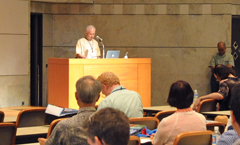
September 18, 2014 Ryukyu Shimpo
On September 17 at the Okinawa Convention Center in Ginowan City, the 18th Foundation of Endangered Languages Symposium was held. It was the first time for the event to be held in East Asia. Researchers presented the critical problem of the dying out of Ryukyuan languages. They also reported on preservation efforts in Hawaii, where the Okinawan community has initiated various activities to perpetuate use of the language. Presenting Ryukyuan dance and performing arts, the symposium showcased the cultural diversity and uniqueness of Okinawa to the world. About 100 people from 21 countries, including speakers and researchers of endangered languages, took part in the symposium.
Chair Shinsho Miyara of the Ryukyuan Heritage Language Society explained the origin and structure of Ryukyuan languages. Professor Masahide Ishihara from the University of the Ryukyus stated, “It is possible for Ryukyuan languages to coexist with Japanese language. If Shimakutuba (Ryukyuan languages) are more used in our daily life, this will establish a positive image of the language, eventually leading us to preserve Ryukyuan languages.”
Professor Tatsuro Maeda from the Tokyo University of Foreign Languages gave a presentation on Amami languages, saying; “In Amami, Kagoshima Prefecture has the administrative authority, and the population size and economic power are also small. Amami faces a more severe situation than Okinawa in preserving its languages. People in Amami and Okinawa need to work together for inheritance of the endangered languages.”
Professor Emeritus at the University of Hawaii Kyoko Hijirida reported on Okinawan language inheritance activities at the university. On September 18 and 19 at the Okinawa International University, researchers attended additional presentations in English that were not open to public.
(English translation by T&CT and Megumi Chibana)
Go to Japanese
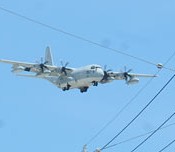
September 16, 2014 Ryukyu Shimpo
On September 15, a KC-130 aerial refuelling tanker, which is stationed at the Marine Corps Air Station Iwakuni in Yamaguchi prefecture, performed “touch-and-go” landings for over an hour as part of training at Futenma Air Station.
After moving the aircraft to Iwakuni at the end of August, the US military has continued bringing the aircraft to Futenma. This is the first time the aircraft has performed a “touch-and-go” landing, a manoeuvre that involves landing on the runway and taking off again without coming to a complete stop.
A KC-130 aerial refuelling tanker flew to Futenma around 11:48 a.m. on that day. From the early afternoon until 2 p.m., the aircraft was used for drills every 5 to 10 minutes.
The U.S. and Japanese governments completed the transfer of all 15 aircraft and squadrons to Iwakuni at the end of August. However, the military had stated that they would continue using the aircraft for training in Okinawa, due to the need to work with ground forces. Many people doubt the transfer actually amounts to a reduction in the base burden on Okinawa.
(English translation by T&CT)
Go to Japanese
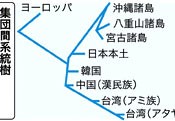
September 17, 2014 Ryukyu Shimpo
Modern people living in the Ryukyu Islands are genetically more closely related to those in the main islands of Japan than people in Taiwan or mainland China, a research team has found. The researchers announced their findings on September 16 after analyzing nuclear genomic DNA. The team consists of Takehiro Sato Ph.D, a research scholar of the University of the Ryukyus, who specializes in medical research, an associate professor of the university Ryosuke Kimura and researchers of the Institute of Statistical Mathematics of Kitasato University. According to the researchers, people started moving from the Ryukyu islands to Miyako and Yaeyama islands 10,000 years ago. The team concluded the Pinza-Abu Cave Man, which was found in Miyako Island and dated to 26,000 years ago, and the Shiraho saonetabaru Cave Man, dated to 20,000 years ago, of Ishigaki island, are not the main ancestors of the people living in Miyako and Yaeyama today.
Previous research results have also shown the people of the Ryukyu Islands are more similar to those in the main islands of Japan than mainland China or Taiwan from bones and DNA analysis of remains. However, this new analysis of nuclear genomic DNA got the same results.
The research results could help further study of the origin of the people of the Ryukyu Islands.
The team collected DNA from a few hundred of people from the main islands of Okinawa, Miyako and Yaeyama islands. The researchers analyzed 600,000 Single Nucleotide Polymorphisms in the human genome. The results showed the native people of the Ryukyu islands and those of Taiwan are in different genetic groups. According to the research results, the people of the Yaeyama islands are genetically not related to those living in Taiwan despite their geographical proximity.
A representative of the team said, “We analyzed the migrations of people of the Ryukyu Islands and Han in China after the Jomon Period. We found that it is highly possible that Minatogawa Man is not the main ancestor of the people in the Okinawa islands.” The researchers said further investigation was needed.
(English translation by T&CT)
Go to Japanese
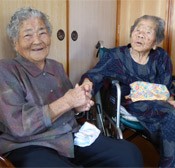
September 11, 2014 Ryukyu Shimpo
Three sisters, 106-year-old Nahe Shuri from Uruma City, 98-year-old Chiyo Moriya from Naha City, and 96-year-old Toyo Agarie from Yonashiro City will next month celebrate Kajimaya, an event that takes place in Okinawa when a person reaches their 97th birthday on the Lunar Calendar. The total age of the long-living sisters will be 300 years.
In September, the thirty-third anniversary of the death of Shuri’s mother-in-law was held at Shuri’s house in Miyagi Island, Uruma City. Moriya could not attend because of a leg injury, but Agarie went and greeted Nahe. Family members and neighbors celebrated the longevity of a more than a century long life.
Both Agarie and Shuri made their livings and raised their children in agriculture. Although Shuri has hearing difficulties, she is responsive in conversation. “I am happy to see everyone,” she smiled.
Agarie, who celebrated Kajimaya, lives close to Shuri’s residence. She joined the anniversary holding her cane, and sat next to Shuri. She said, “My elder sister was like my mother because my mother passed away when I was five. I am always happy to see her.”
Agarie told the people at the gathering that doing exercise and eating vegetables are her secrets of longevity.
Seiyu Moriya, the first son of Chiyo Moriya said, “Although Chiyo could not attend because of her leg problem, she is still smart and has a big mouth. I hope the three sisters stay healthy and live longer. They are treasures of Okinawa.” The three sisters will gather at Agarie’s Kajimaya celebration, which will be held on October 18.
(English translation by T&CT and Megumi Chibana)
Go to Japanese
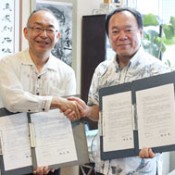
September 5, 2014 Ryukyu Shimpo
The Okinawa Prefectural Education Board and the Japan International Cooperation Agency (JICA) plan to send teachers to Bolivia and Laos from the 2015 fiscal year. The head of the education board Akira Moromizato and the head of the JICA Okinawa International Center Makoto Kashiwaya reached an agreement at the prefectural education bureau office on August 28.
JICA will work with the prefectural government to recruit teachers and choose candidates.
They plan to send a teacher to “Colonia Okinawa,” one of the settlement sites established by Okinawan Bolivians, every year for two years. The teachers will be sent to two schools in two of the settlement sites. They will carry out the project until the 2021 fiscal year.
The prefectural government and JICA also plan to send a teacher to a junior teacher training college in Laos every year for two years. They will carry out the project until the 2017 fiscal year.
The teachers selected to go to the countries will take a training course from next April. Their placements will commence in July.
(English translation by T&CT)
Go to Japanese
September 12, 2014 Ryukyu Shimpo
A Japanese coast guard officer has intimidated a man by pressing his hand against the man’s throat. Another twisted a woman’s arm.
Such acts of violence are taking place on a daily basis, on the sea surrounding Henoko in Nago .
We definitely cannot allow the Japanese government to condone the use of brute force to restrain civilians protesting against the unwanted construction of a new base to replace Marine Corps Air Station Futenma in Henoko, Nago.
Despite several civilian injuries, the Japanese coast guard has not provided an explanation, and claims it does not know what happened.
Despite the media reporting on the use of force by coast guard officers against civilians, the coast guard has not even tried to clarify the facts. This leads us to think they must approve of the violence. We have to assume the agency has established a security policy condoning the removal of protesters by brute force.
When has the agency ever stooped so low as to become a violent organization?
The agency deems the act of protesters going beyond the floats marking a new restricted area as a “crime.” Despite temporarily constraining civilians, sometimes resulting in injury, the coast guard claims this is its way of “asking protestors to voluntarily leave the area to secure their safety”.
Based on the coast guard officers’ conduct on the water, “securing safety” clearly means safety of the construction site, not the safety of the civilians who protest. It is in doubt whether the agency is really concerned at all about the safety of civilians.
The director of the agency Yuji Sato said, “The officers have been doing well to secure safety.”
His statement is beyond belief. Any way you look at it, the top officials in the agency clearly approve of the violence that is in fact putting protestors in danger, not securing their safety.
The 11th Regional Maritime Safety Headquarters also claimed that what the coast guard officers are doing does not amount to a crack-down on the protesters. Such claims are at odds with the reality.
One of the protesters who went beyond the float was held under water by two officers several times. He said he felt his life was in danger. This is clearly an indication of a severe crackdown on civilians.
If the officers have been given orders not to allow the protesters to go beyond the floats, it is easy for them to do so without the use of violence because they are physically stronger than the protestors. It is an aberration that the officers are using gratuitous violence to remove the protestors.
One of the protesters was held in a “full nelson” (restrained at the neck and head) by three officers and his head was hit hard against the floor of the ship. He suffered from a cervical sprain which takes 10 days to heal completely. He filed a criminal complaint to the Naha District Court. The court has accepted it.
The agency should take notice of the fact that three of the coast guard officers have been charged with assault, and the district court has accepted the charges. We cannot comprehend why the officers continue to use a violent approach to security.
The agency should acknowledge the abnormality of suppressing non-confrontational civilians by brute force, and suspend its security activities.
(English translation by T&CT)
Go to Japanese
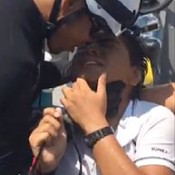
September 11, 2014 Ryukyu Shimpo
Coast guard officers are employing violence against residents amid increasingly heated protest against work to relocate US Marine Corps Air Station Futenma to an offshore site in Henoko, Nago. On September 9, at the construction site, members of the coast guard yelled at a resident while pressing his neck and twisting his arm. The violence was witnessed by onlookers. Since the coast guard began carrying out its security operations in Henoko, it has not responded to news media inquiries.
Senior officials of the coast guard have said they see it as a crime if residents enter an area of the sea cordoned off by buoys. The 11th Regional Coast Guard Headquarters also suggested to Okinawa Prefectural Assembly members that the coast guard would respond with force if citizens moved into the restricted area, referring to regulations such as the Act on Special Measures Concerning Criminal Cases. However, the officials did not comment on individual cases. The coast guard maintains their tough stance against the residents’ protest.
As of September 10, some residents had been injured by the coast guard members’ violence and required medical attention. However, the Japan Coast Guard headquarters in Tokyo says they have no information regarding whether or not there have been any injuries to residents as a result of its security activities in Henoko. One of the injured residents submitted a complaint to the Nago branch of the Naha District Public Prosecutors Office on September 9. The prosecutors’ office accepted the indictment, and it has begun an investigation.
(English translation by T&CT)
Go to Japanese
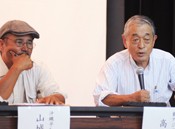
September 14, 2014 Ryukyu Shimpo
On September 12, the Ryukyu Okinawa Center of the East Asian Community Research Institute held a lecture meeting in Naha City. Journalist Hajime Takano stressed in his lecture that “stationing US Marine Corps in Okinawa is unnecessary.” Director of the Okinawa Peace Movement Center Hiroji Yamashiro reported on activities to oppose the government’s work towards the construction of a new US air base to replace US Marine Corps Air Station Futenma. The president of the Institute is former Prime Minister Yukio Hatoyama.
Takano, referring to the disputed Senkaku islands, said, “The Abe administration has been spreading a false rumor that China will come and take the Senkaku Islands. [It decided in July to reinterpret the Constitution to allow Japan to exercise the right of collective self-defense.]They expect that the United States will help Japan based on the right of collective self-defense. However, President Obama and US forces in Japan have not agreed to do so.”
Referring to the joint press conference when President Obama visited Japan in April, Takano pointed out “President Obama told Prime Minister Abe it would be a profound mistake to continue to see escalation around this issue instead of dialogue,” and the President also said he would like to welcome the peaceful rise of China.
While in Japan, Obama re-stated that the security treaty covers the Senkaku islands. Takano said, “This is written in the Japan-US Security Treaty. The Defense Secretary and Secretary of State have made the same comments many times.“ He also said, “The assertion that stationing the US Marine Corps in Okinawa is unnecessary has become wide-spread recently among experts in the United States, but this is not reported in Japan.”
Yamashiro strongly criticized the Japan Coast Guard for its harsh attitude towards the citizens’ movement opposing the construction of a new US air base in Henoko.
(English translation by T&CT)
Go to Japanese
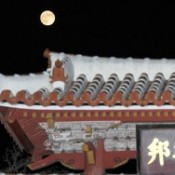
September 10, 2014 Ryukyu Shimpo
The super moon was observed on September 9 when it looks its largest all year in various regions in Okinawa. This is an astronomical phenomenon when the moon looks larger than usual because it is closer to the earth. At Shurijo Castle Park in Naha, many tourists and amateur photographers took in the scenes of the moon and the castle. Kazuko Kuniyoshi, who visited the park for a walk, said, “I have never seen such big moon. I was so impressed. It was a very mysterious.”
(English translation by T&CT)
Go to Japanese
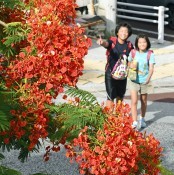
September 3, 2014 Ryukyu Shimpo
Pedestrians are enjoying the blooming bright-red Royal Poinciana in Yosemiya, Naha. The Royal Poinciana is from Madagascar and belongs to the bean family. It blooms between June and October. This tree is called Houo Boku in Japan, named after the Chinese Phoenix because the flowers swinging in the wind look like a flying Chinese Phoenix.
Kayoko Tamashiro, who lives in Yosemiya, said, “Every year, I am fascinated by the bright-red flowers. And the trees create shade while we wait at stoplights.” Hoshin Kohagura said, “The bright red color matches Okinawa’s colourful image.”
(English translation by T&CT, Hitomi Shinzato)
Go to Japanese
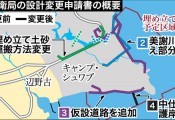
September 4, 2014 Ryukyu Shimpo
On September 3, the Okinawa Defense Bureau filed an application to the Hokubu Regional Public Works Office requesting approval for modifying part of the construction methods for reclaiming the sea at Henoko, Nago for the relocation of the U.S. military’s Futenma Air Station. The application is based on the Public Water Body Reclamation Act. The Okinawa Defense Bureau must also get approval from the governor of Okinawa . The governor is likely to approve the application in early October after considering environmental conservation factors. This will likely be a talking point in the run-up to the gubernatorial election in November.
The four modifications are: (1) The additional placement of three temporary roads on Henoko Peninsula within Camp Schwab; (2) the addition of partitioning revetments that will be passageways during the reclamation works; (3) a change to the location at which Mija River will be diverted; and (4) a change to the method used to bring in the earth and sand used for the reclamation. Among these four points, (3) and (4) were put to Nago City for consultation. There will also be consultations with Nago City over the issue of usage of the Henoko fishery harbor, which was the planned location of a construction operations yard for the landfill. The area is administered by the city.
The additional temporary roads will connect with already-approved temporary roads, forming 3 roads encircling Henoko Peninsula. Along the coast of Henoko Peninsula, “partitioning revetments”, will be constructed and will become temporary roads during the filling-in of the sea with earth and sand.
Meanwhile, the planned installation of a conveyer belt for the transport of earth and sand from the area around Henoko Dam, which is located near the hilly areas on the inland side of National Route 329, has been cancelled. This is because the proposal crosses the surface of the reservoir of Henoko Dam, which is administered by Nago City, and the city is expected to reject the proposal.
Instead, a construction bridge will be built straddling Route 329, and a temporary road will be placed from the bridge to the coast through Camp Schwab. In addition, Route 329 will be used for the transport of earth and in large trucks.
(English translation by T&CT and Lima Tokumori)
Go to Japanese










 Webcam(Kokusai Street)
Webcam(Kokusai Street)


